Climate of Man assignment
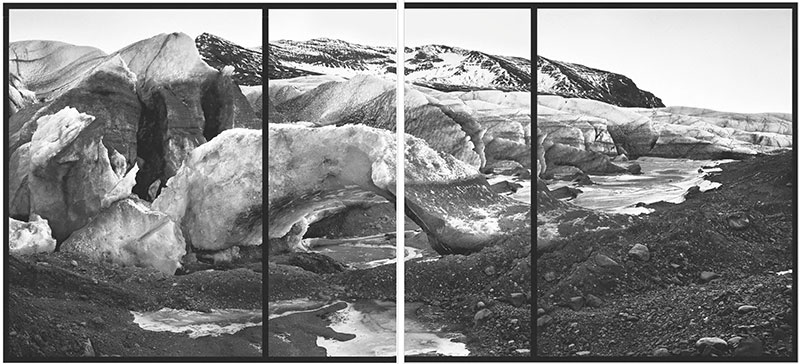
- The Climate of Man - Part I - My scan (picture of the article) as a .pdf.
- The Climate of Man - Part I - A web page at The New Yorker. Limited number of free article accesses per month, but contains the actual text of the article. That is, it's easier to copy some text into your personal notes.
Questions and your responses
Write short responses to these reading questions, as you read the first part (pages 56-65) of this article.
A a few of you wrote that you looked up unfamiliar terms. Excellent!
- Read the title and one phrase summary, the name of the author and the date, and peruse the "banner image". Before you start reading the article itself write down: What are your expectations of what the article is about based on these elements alone?
The dramatic black and white image shows an icecap that is barely ice.
...the title contradicted the author, as it states the idea of man but written by a woman.
- This article is from "The New Yorker" magazine. Take a look at their homepage. What can you guess about their audience? That is to say...what kind of person will this author be writing for?
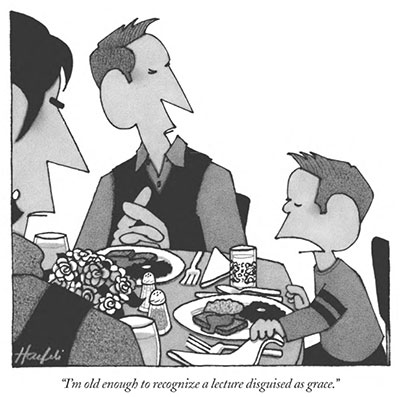 By the way,
The cartoons are not related to the article content! In the print version of the magazine (from which this copy has been made), cartoons, advertisements, and poems are sprinkled around throughout the magazine, with no connection to the articles around them.
By the way,
The cartoons are not related to the article content! In the print version of the magazine (from which this copy has been made), cartoons, advertisements, and poems are sprinkled around throughout the magazine, with no connection to the articles around them.
When scrolling through the homepage, the articles that come up as recommended range from political to scientific.
- Focus on the first full paragraph on page 58, beginning "Soon, the changes in the sea ice brought other problems": There are an awful lot of numbers in that paragraph! Why do you think the author put all those specific numbers in there?
The use of “12 foot waves” and “a hundred and twenty-five foot wide strip” gives a relative visual to the reader in comparison to just saying “big waves”.
[S]he put those numbers there so people can understand the severity of the situation when it comes to carbon dioxide and the rising temperatures.
Another reason the author uses specific quantities is to make the reader trust the information as there is proof behind it.
From a report about a conference on uncertainty:Being trustworthy depends not on conveying an aura of infallibility, but on honesty and transparency.
- In the section on the Charney report, Kolbert argues that "waiting for the evidence [of warming] to assess the [climate] models accuracy" is risky. Why? Say a little bit about whether you agree or disagree and why.
It's risky...because once the first effects are evident it will take a long time to reverse course.
I disagree with this because waiting for the evidence can potentially understand why climate change is happening to the specific place and a potential solution to get it better.
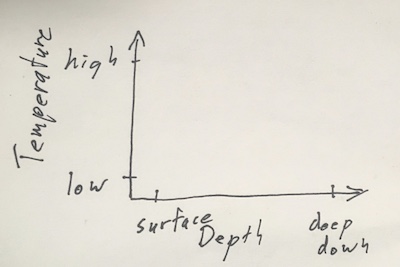 Kolbert describes how the temperature varies with depth in permafrost in equilibrium--"when the climate is stable"--and how it's different now.
Make a graph of the temperature as a function of depth as it looked a long time ago, and as it looks more recently. You could use a set of axes like that shown here.
Kolbert describes how the temperature varies with depth in permafrost in equilibrium--"when the climate is stable"--and how it's different now.
Make a graph of the temperature as a function of depth as it looked a long time ago, and as it looks more recently. You could use a set of axes like that shown here.
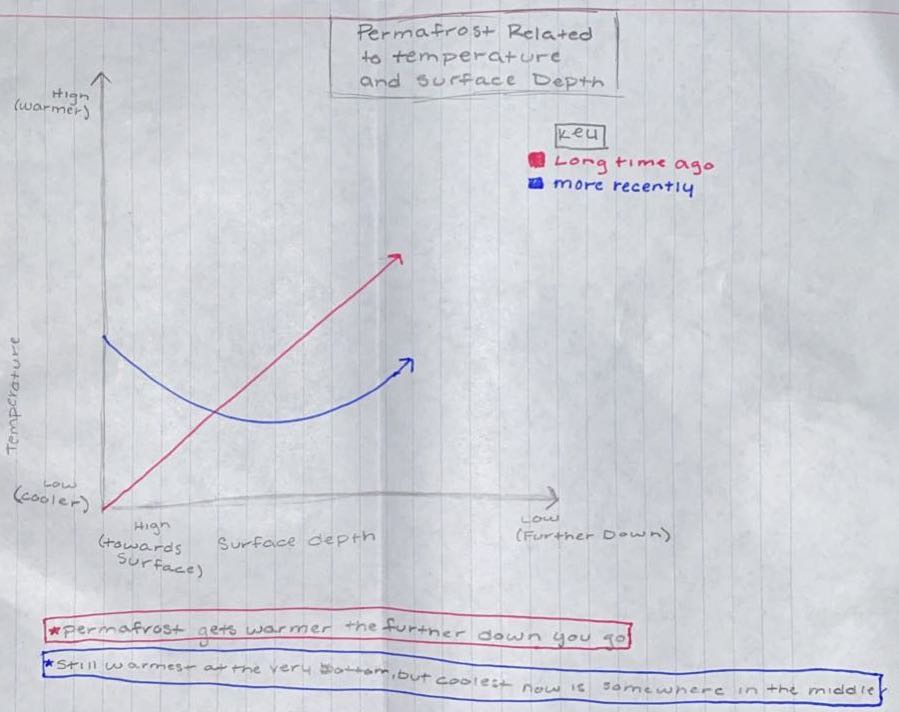

- Why is temperature in permafrost a better indicator of long term trends compared to air temperatures?
It is a better indicator because the air temperature is so variable.
The temperature in the permafrost shows general trends rather than quick fluctuations.
Many of you wrote about permafrost, as Kolbert wrote, about it being a "low pass filter". A better term might be a slow pass filter. The air temperature varies rapidly from day to day and month to month. But it takes a long time for the permafrost to heat up or cool down. So, it's only sensitive to the slow, long term changes of temperature. That is it shows the the slow changes, they pass through the filter, but filters out the rapid changes.
- Kolbert has a number of details about the people she is tagging along with, that seem to have little to do with the climate change theme of the article. Such as:
- Morris Kiyutelluk, who is sixty-five, has lived in Shishmaref almost all his life. (His last name, he told me, means "without a wooden spoon.")
- Panikov told me that he was quite convinced that Martian life existed--or, at least, had existed. Romanovsky expressed his opinion on this by rolling his eyes; nevertheless, he had agreed to help Panikov dig up some permafrost.
...without detail such as “rolling his eyes” the reader would not pick up on his emotions
Kolbert appealed to both [emotion] and [facts] making it more likely that the reader would care.
It makes the scientists more human.
They have become part of her experience throughout this journey.
I believe that Kolbert includes such details so that the reader can see them as regular human beings rather than [just] scientists. The reader will be left with the idea that scientists can also make bad jokes and have emotions.
I think that she includes these details to keep the reading from being so content intensive. These details are a contrasting light to the heaviness of global warming.
Kolbert’s inclusion of details such as Romanovsky and his munching on Tostitos ... establishes Kolbert’s credibility by providing details that can’t just be researched, and have instead been experienced.
[She manages to avoid boring us] by constantly going back to the people she introduces us to.
There is so much information within this passage that taking a small moment to describe a real life event keeps the reader engaged.
- During her travels with Donald Perovich, Kolbert describes a "positive feedback" involving the albedo of ice. In your own words, summarize how that works, and why it's a big deal.
The sun warms up the sea, which melts the ice, which makes the heat get absorbed, which makes the ice melt quicker, leaving less ice to reflect the sunlight back, which just makes everything hotter.
"It takes a small nudge to the climate system and amplifies it into a big change."
-Donald PerovichRecent measurements show that The Arctic is warming four times as fast as the rest of the planet. This albedo feedback is a big part of the reason for that.
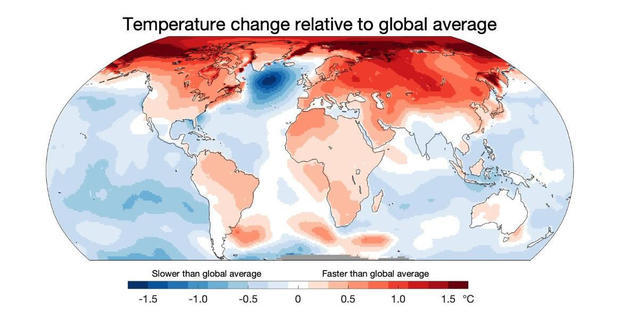
Ed Hawkins, via CBS News, 2021.
And the blue spot is a result of the red in the Arctic....Why might the Arctic be different from the Antarctic?
If we start tipping global warming to make it colder, there could be a good balance.
This is hints at the possiblity "social" tipping points!
- Later she lays out the scientific understanding of why Earth has had ice ages in the past, and describes and discusses this with Perovich in the context of what he calls "tipping points". What is the scientists' explanation of why Ice ages have happened? And how is the idea of a "tipping point" related to understanding that?
Scientists have explained the ice ages to be like the albedo feedback to be happening in reversa. Instead of the earth getting warmer, it starts getting cooler and this starts to create more ice, which causes sunlight to reflect back into the atmosphere, which just makes the earth even cooler. This relates to the tipping point because it just keeps on going faster and faster.
...And what causes it to start "getting cooler"?It is now known, or at least almost universally accepted, that glacial cycles are initiated by slight, periodic variations in the earth's orbit.
Ice ages are caused by periodic variations in the earth's orbit [and tilt and wobble.]. This causes changes in the way sunlight is distributed to different parts of earth. It can cause the albedo to increase opposite to how it is now and just create more and more ice.
- Write up your personal reaction/response to this article [so far] in two or three paragraphs. (About 250-400 words) What stood out to you? What surprised you? What did you doubt? What do you wonder about after reading this article?
[I liked] the personal details she put in of her own experience..."I got some paper towels to mop it up but the puddle was too big".
Overall, the article felt more personal with a hint of brooding curiosity, not quite the detached accusatory tone I was expecting.
Reading about climate change is hard for me because I feel so helpless to stop it.
I found myself getting angry at past generations
It feels very hard to find solutions to problems that have been occurring for many years and are sometimes irreversible.
Now if I am honest, I am not sure if I want to know how much damage has been done to the world.
I am curious [about what happened since 2006.] One internet search tells me that very little progress has been made [on moving Shishmaref].
...the thing that stood out to me the most was all the experiences the author had.
Will... animals start moving up North?
One of the things that I wonder after reading the article is if measures are taken in order to slow down the effects of global warming, how long will it take until we start to see from that. Global warming isn’t something that has happened overnight and results aren’t going to happen overnight either. So how long would it be until the results are seen.
This is a very interesting question. You are not the only one to wonder about this:
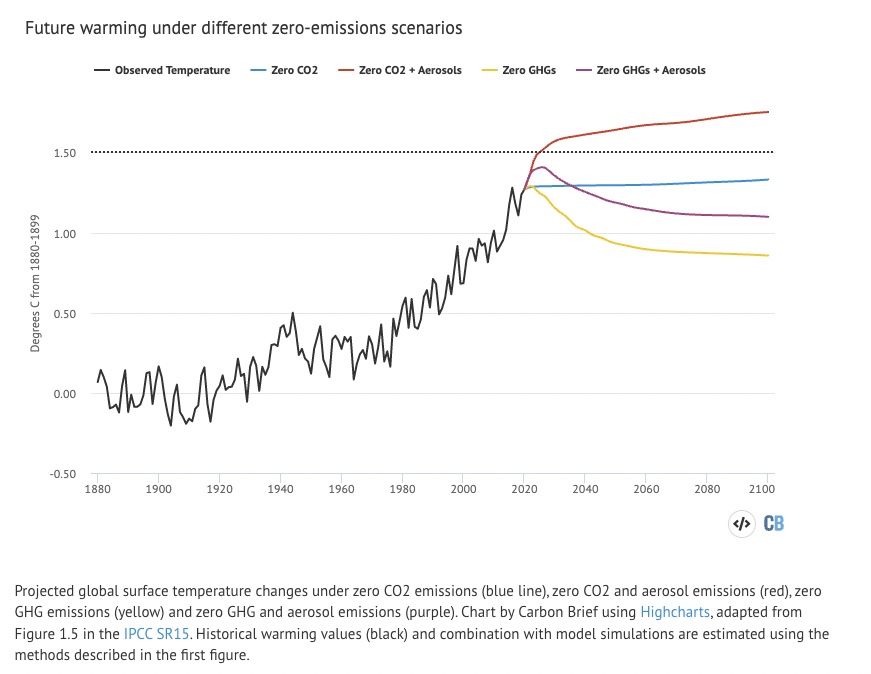 Results of recent modeling (2019) indicate that temperature would change, at the worst by +0.4 C. But depending on which emissions go away, warming would stop (or even start to go down) almost immediately after "net-zero" emissions.
Results of recent modeling (2019) indicate that temperature would change, at the worst by +0.4 C. But depending on which emissions go away, warming would stop (or even start to go down) almost immediately after "net-zero" emissions.
Second half of the article
Questions will follow later...
For this assignment, finish the article (page 65-end), and write responses to these questions.
-
"Natural" greenhouse effect: What is Earth's average temperature now? What do scientists think it would be without any of the (naturally-occurring) greenhouse gases?
The average global temperature is 57 degrees [F]. Without greenhouse gases, it is supposed to be at 0 degrees [F].
- "Enhanced" (human-caused) greenhouse effect: Svante Arrhenius made the first calculation of the effect of
doubling the amount of carbon-dioxide in Earth's atmosphere. But Kolbert writes "the general assumption was that the oceans would absorb just about everything humans could emit."
How much of human carbon emissions do scientists think the oceans are recently absorbing? How does that affect the oceans? Look around on the Web a bit for answers to these two questions (and say what your sources are).
Oceans absorb about 31% of carbon emissions, according to the NOAA (National Oceanic and Atmospheric Association). Research has found that though this phenomenon reduces the level of atmospheric warming (which is a good thing) there are harmful effects as well. Oceanic absorption causes sea waters to acidify which threatens coral life and marine species.
Others found percentages ranging from 20-40%.
More carbon dioxide can be absorbed in frigid waters compared to warm waters, as they absorb less. In other words, as the oceans warm up, “they will become less and less capable of taking up carbon dioxide..."
- Another feedback mechanism might be accelerating the loss of Greenland's ice sheet. Describe how that one works.
As snow melts on the ice sheets it increases the flow of ice towards the ocean where ... the sheet is melted into the water. Since this occurs at a faster rate than the snow can reform the ice it gets worse every year as the cycle speeds up.
- Specifically in Iceland... How is information about the size of glaciers in Iceland gathered? How far back does it go?
The Icelandic Glaciological Society was founded in 1930. Measurements are taken [by volunteers] with iron poles and tape measures.
...building cairns and pacing off distances to the edge of the glacier.
This shows the significance of the glaciers to the people that live ... near them.
Another example of citizen science:
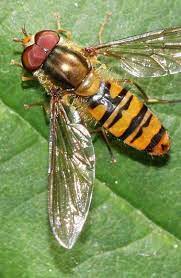 For 27 years, members of the Krefeld Entomological Society near Dusseldorf have monitored flying insect populations ... in dozens of nature reserves. In recent years, they
noticed a steep decline in their catch, with biomass dropping by some 82% in the summer when insect populations peak.
For 27 years, members of the Krefeld Entomological Society near Dusseldorf have monitored flying insect populations ... in dozens of nature reserves. In recent years, they
noticed a steep decline in their catch, with biomass dropping by some 82% in the summer when insect populations peak.
Hoverfly, Independent.ie"Phenology" is the study of seasonal changes--e.g. when particular flowers bloom or leaves turn. Inspired by seasonal flowering observations made by Richard Marsham starting in 1736, continued by his family until 1947 many UK gardners and amateur naturalists have been keeping records, and reporting to initiatives like "Nature's Calendar", now formally called citizen science.
- Towards the end of the article, Kolbert attends a multi-nation meeting on climate change. She writes:
Corell observed that the loss of sea ice since the nineteen-seventies was equal to "The size of Texas and Arizona combined. That analogy was made for obvious reasons".
An analogy is "a comparison between two things, typically for the purpose of explanation or clarification." What do you think the "obvious reasons" were for using that analogy?This specific analogy was made because the people who were unwilling to agree on a strict plan to combat climate change were american. This analogy was made to hit harder on the americans in order to hopefully get them to listen.
- What questions and thoughts occur to you from this second half of the article? Write a short personal response of 200-300 words.
I can see many people disregarding the content of the article because the glaciers wouldn't "affect them".
This echoes a concern that Katharine Hayhoe voices:
Recent surveys from the Yale program on Climate Change Communication:
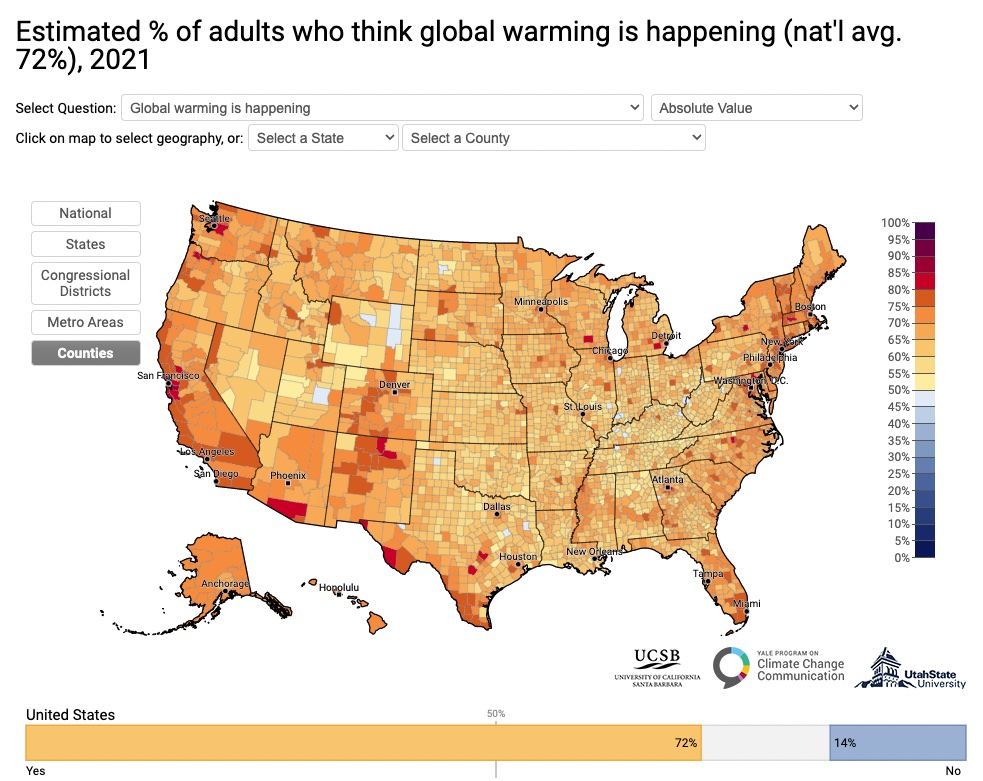
Yet...
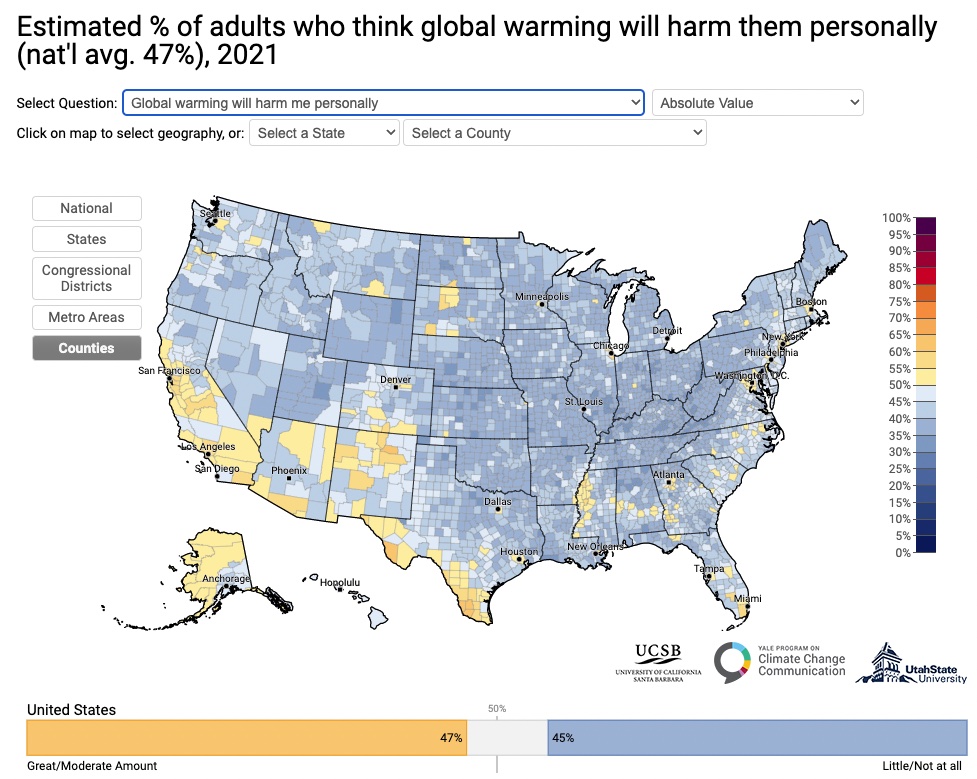
I was wondering how, if the oceans weren't a carbon sink before, how did it start?
There are and were, always atoms of CO2 moving in both the air and in the waters of the oceans.
After a while the concentrations of each is not changing very much: "dynamic equilibrium". Here's a simulation of 2 different kinds of "atoms". PHET diffusion simulation
But if you add a bunch more CO2 molecules into the air, that will increase the atoms in the ocean too.
The thing I wonder about is... what if we're too late [to respond to climate change].
Overall impressions
scientists have been working on finding the reason for global warming and the greenhouse gases and its effect since decades ago.
The story gave the readers a personal connection to the over-b earing stats that are usually written about in an article covering climate change and global warming.
Why is this not being talked about more[?] Yes, global warming is talked about a lot but things are rarely ever done about it...
Is the harm we have done reversible?
The Ozone hole
Yes, there has been a thinning of Earth's ozone layer. It's particularly acute over Antarctica, and thus we call it a "hole". But there is somewhat less ozone all over Earth.

The same chemicals (Chlorofluorocarbons - CFCs) that destroyed atmospheric ozone are also potent GHGs. CFCs have largely been replaced by HFCs (Hydrofluorocarbons) which are harmless to ozone but have a global warming potential (GWP) several thousand times that of $CO_2$.
The main concern about loss of ozone is the increased amount of UV light from the sun that makes it through Earth's atmosphere. This can lead to:
- Increased skin cancers
- Increased cataracts
- Increased death of Antarctic plankton--food source at the bottom of the Antarctic food chain
But "ozone depletion is not a major cause of climate change" [NOAA].
Postscript
Kolbert writes:
Zwally told me that he had once seen spy-satellite photos of the region [of the Greenland ice sheet] that we were crossing and that they had shown that undrneath the snow it was full of crevasses. Later, when I asked Steffen about this, he told me that he had had the whole area surveyed with bottom seeking radar, and no crevasses of any note had been found. I was never sure which one of them to believe.
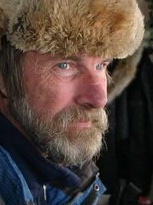 Konrad Steffen died in 2020 close to Swiss Camp in Greenland.
Konrad Steffen died in 2020 close to Swiss Camp in Greenland.
